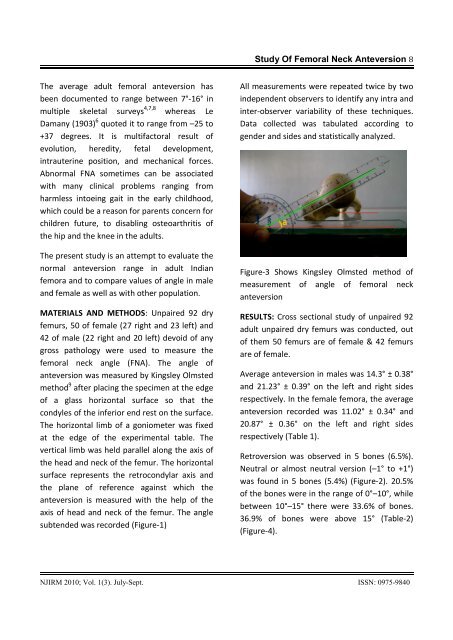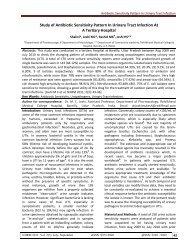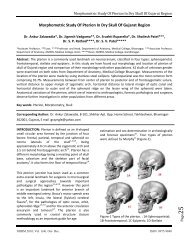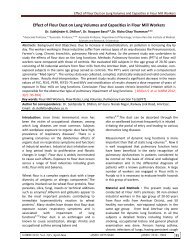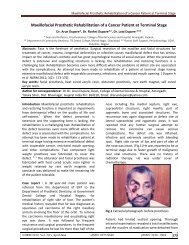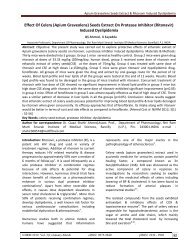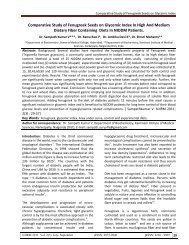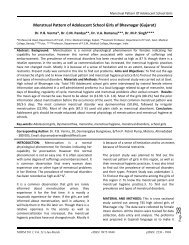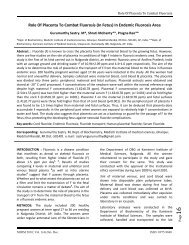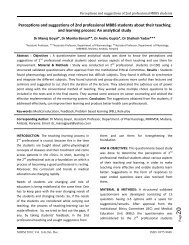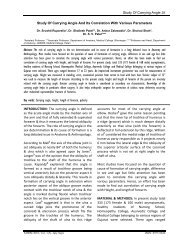Study Of Femoral Neck Anteversion 7 Study Of Femoral Neck ... - njirm
Study Of Femoral Neck Anteversion 7 Study Of Femoral Neck ... - njirm
Study Of Femoral Neck Anteversion 7 Study Of Femoral Neck ... - njirm
You also want an ePaper? Increase the reach of your titles
YUMPU automatically turns print PDFs into web optimized ePapers that Google loves.
The average adult femoral anteversion has<br />
been documented to range between 7°-16° in<br />
multiple skeletal surveys 4,7,8 whereas Le<br />
Damany (1903) 6 quoted it to range from –25 to<br />
+37 degrees. It is multifactoral result of<br />
evolution, heredity, fetal development,<br />
intrauterine position, and mechanical forces.<br />
Abnormal FNA sometimes can be associated<br />
with many clinical problems ranging from<br />
harmless intoeing gait in the early childhood,<br />
which could be a reason for parents concern for<br />
children future, to disabling osteoarthritis of<br />
the hip and the knee in the adults.<br />
The present study is an attempt to evaluate the<br />
normal anteversion range in adult Indian<br />
femora and to compare values of angle in male<br />
and female as well as with other population.<br />
MATERIALS AND METHODS: Unpaired 92 dry<br />
femurs, 50 of female (27 right and 23 left) and<br />
42 of male (22 right and 20 left) devoid of any<br />
gross pathology were used to measure the<br />
femoral neck angle (FNA). The angle of<br />
anteversion was measured by Kingsley Olmsted<br />
method 9 after placing the specimen at the edge<br />
of a glass horizontal surface so that the<br />
condyles of the inferior end rest on the surface.<br />
The horizontal limb of a goniometer was fixed<br />
at the edge of the experimental table. The<br />
vertical limb was held parallel along the axis of<br />
the head and neck of the femur. The horizontal<br />
surface represents the retrocondylar axis and<br />
the plane of reference against which the<br />
anteversion is measured with the help of the<br />
axis of head and neck of the femur. The angle<br />
subtended was recorded (Figure-1)<br />
<strong>Study</strong> <strong>Of</strong> <strong>Femoral</strong> <strong>Neck</strong> <strong>Anteversion</strong> 8<br />
All measurements were repeated twice by two<br />
independent observers to identify any intra and<br />
inter-observer variability of these techniques.<br />
Data collected was tabulated according to<br />
gender and sides and statistically analyzed.<br />
Figure-3 Shows Kingsley Olmsted method of<br />
measurement of angle of femoral neck<br />
anteversion<br />
RESULTS: Cross sectional study of unpaired 92<br />
adult unpaired dry femurs was conducted, out<br />
of them 50 femurs are of female & 42 femurs<br />
are of female.<br />
Average anteversion in males was 14.3° ± 0.38°<br />
and 21.23° ± 0.39° on the left and right sides<br />
respectively. In the female femora, the average<br />
anteversion recorded was 11.02° ± 0.34° and<br />
20.87° ± 0.36° on the left and right sides<br />
respectively (Table 1).<br />
Retroversion was observed in 5 bones (6.5%).<br />
Neutral or almost neutral version (–1° to +1°)<br />
was found in 5 bones (5.4%) (Figure-2). 20.5%<br />
of the bones were in the range of 0°–10°, while<br />
between 10°–15° there were 33.6% of bones.<br />
36.9% of bones were above 15° (Table-2)<br />
(Figure-4).<br />
NJIRM 2010; Vol. 1(3). July-Sept. ISSN: 0975-9840


